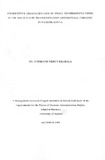| dc.contributor.author | Khabala, Everlyne M | |
| dc.date.accessioned | 2013-05-16T12:26:09Z | |
| dc.date.available | 2013-05-16T12:26:09Z | |
| dc.date.issued | 2007 | |
| dc.identifier.uri | http://erepository.uonbi.ac.ke:8080/xmlui/handle/123456789/23622 | |
| dc.description.abstract | This report presents a study on the pattern of traditional distribution channels adopted
by the public universities in Kenya. The first objective to determine the patterns was
approached from a bilateral view point; first, to measure the intensity-level of distribution
for each institution is developed from these two dimensions: (1) Outlet concentration
(the extent to which locations and intermediaries for each institution are present in a
given geographical territory) and (2) Outlet spread (dispersion of the locations and
intermediaries for each university within the national scope). Secondly, patterns were
also described by length. Both statistical and qualitative data were collected using a
structured questionnaire administered to single representatives of each of the 7 public
institutions. The Index of Dissimilarity and GINI Coefficient models were used as the
basis of determination of concentration and spread respectively.
It was found that all the seven public universities apply both zero level and level one
channels. Secondly, all the three traditional patterns of distribution known to marketing
theory (intensive, selective and exclusive) are applied differently by different
universities.
The criteria followed in the selection of locations for level zero channels saw the
presence of target market as the major factor with a mean score of 8.5 out of ten. On
" the other hand the criteria followed in the selection of intermediaries for the level one
channels saw the facilities of the middle level college as the major factor with a mean
score of 8.625 out of ten.
The factors that have led to the use of the level zero channel saw expansion as the
leading factor with a mean score of 8.9 out of ten. For the level one channel the factors
that have led to its application saw type of programmes run by the middle level college
as the leading factor with a mean score of 8.5 out of ten.
(ii)
From the findings contained herein it is clearly demonstrated that public university
programmes are distributed using various patterns and lengths and it is strongly
recommended that the use of distribution channels by public universities be exploited
using an optimal distribution mix to achieve broader corporate objectives such as
sustainable competitive advantage, profitability, growth, maximization of both customer
and shareholder value, social and corporate responsibility and surviva | en |
| dc.description.sponsorship | The University of Nairobi | en |
| dc.language.iso | en | en |
| dc.subject | Small mushrooming firms in the solid waste transportation and disposal | en |
| dc.title | Competitive strategies used by small mushrooming firms In the solid waste transportation and disposal industry In Nairobi, Kenya | en |
| dc.type | Thesis | en |
| local.publisher | School of Business ( SOB ) | en |

